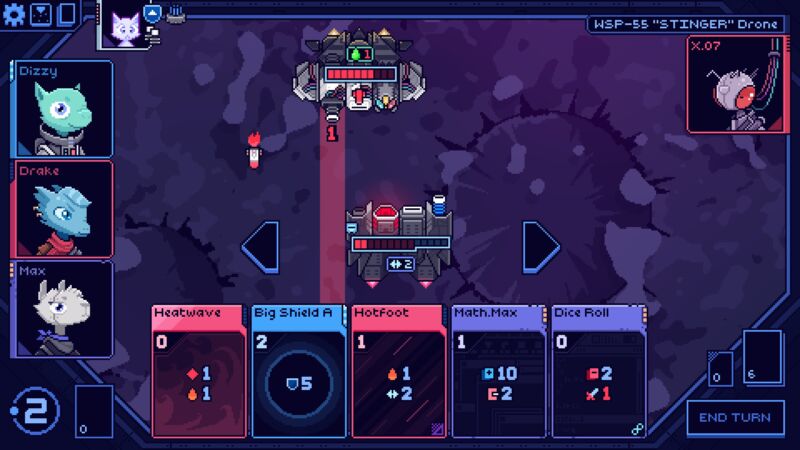It’s got style, dialogue, and even a plot on top of procedural card battling.

Games come and go through my Steam and Nintendo Switch libraries: a twitchy, grim action epic, then a metaphysical puzzle-platformer, and maybe a boomer shooter or turn-based tactical along the way. I try hard not to get stuck in one style or mindset—both for my enjoyment and my writing.

But there is always one type of game that is installed and ready to go for the next trip or idle couch moment: a roguelite deck-builder. Cobalt Core is the latest game in that slot, and it’s on Steam for Windows (and definitely Steam Deck) and Switch. It’s the most fun I’ve had in this particular obsession since Monster Train. Cobalt Core stretches into other genres, like perfect-knowledge turn-based tactics and space battle, but it’s cards and randomness down to its electric-blue center.
A few years ago, I didn’t know what a “roguelike deck-builder” was or what either of those compound phrases meant. Then, one day, there was a sale on Slay the Spire. That 2019 game refined the fusion of two game mechanics: constant failure against randomized encounters (a la Rogue, but with a “lite” gradual progression) and the refining of a deck of combat-minded cards (as in Magic: The Gathering, Dominion, and Netrunner). You attack and defend against increasingly tough enemies with your cards, you gain and upgrade and ditch cards as you go, you lose, and then you get slightly better tools on your next do-over.Advertisement
Done well, roguelike deck-builders are a potent mix of luck, immediate and long-term strategy, and the slow dopamine drip of chained-together victories. I’ve lost entire work months to them, cumulatively. They should come with a warning label.
Cobalt Core has all those addictive elements plus a few more things to do with your cards. For one, there is space jockey positioning. You move your ship left and right against your opponents, lining up beam emitters and missiles, targeting weak points, and dodging. You do this with perfect Into the Breach-like knowledge of the opposing ship’s actions: it’s going to fire from this bay for 2 damage, use this bit to upgrade shields, and so on. This leaves you with the decisions of when to take hits versus dodging, where to launch drone cannons, whether to attack now or wait for better cards next hand.
- A mid-battle scene, with your ship (on bottom) in the midst of delivering a hull-smashing attack, just before the enemy’s multiple red beams rain down. Brace Yourself Games
- You pick your battles in Cobalt Core, and also choose repair shops, random happenings, and mid-level bosses. Brace Yourself Games
- The cards you’re offered depend on which cremates you picked for this run, and each has a distinct discipline. Brace Yourself Games
- The cover art for Cobalt Core, which makes you really not want to get your new friends blown up. Brace Yourself Games
On top of working those elements into fine shape, Cobalt Core cleverly embraces them in its plot and theming. Your ship is made up of quirky characters, each of whom adds their cards with unique play styles to your deck. You fight ship after ship, encounter celestial oddities, warp from sector to sector, then fight the titular object. When you beat it, you … do something, in space and time, it seems, then start over with imperfect memories of prior loops. Each win or notable loss unlocks new crew, cards, and memories, enough of which might explain what exactly is going on in this heady quantum plot.Advertisement
What’s largely drawn me in is how neatly the game’s battles and runs fit into a casual gaming schedule. A single battle is usually less than five minutes, a sector of fights maybe 15–20, and a couple sectors plus a boss fight 30–40 minutes, though the decisions and early sections get faster as you learn them. You can save and exit anytime, even mid-battle, and it’s a fast-loading game. On the Switch or Steam Deck—for which this game is Verified and a real battery-saver—it makes for a generous couch, waiting room, or travel experience.
I’ve still got a lot to unlock in Cobalt Core after 10 hours of play, and could easily see myself hitting the 100-plus I put into Slay the Spire and Monster Train (or at least the 50 I threw into Inkbound or SteamWorld Quest). It helps that there’s much more singular personality and style in Cobalt Core than other procedural card battlers. And humor, too, lots of it, accompanied by appealing 16-bit-esque graphics, making the grind for new cards and esoteric achievements feel far less grinding.
It’s also impressive how much character-building the game pulls off in service of pixel portraits that never move but frequently react, quip, and express their quantum confusion. I typically feel nothing for different characters in these games. But I’ve got a soft spot for the gunner Riggs, and feel bad when I skip him for, say, movement or hacking options.
My major complaint about Cobalt Core, this deep into its clutches, is that its soundtrack is catchy. This is normally a positive, but given how regularly I’m dropping in for a round or two or 10, I find my mental synth deck replaying the melody lines from a few different tracks. I can’t hum a single note from any of the orchestral-minded backings of my prior deck-builder obsessions, but these tunes are burrowing deep inside.
Cobalt Core is currently on sale (on both platforms), and its base price is $20–$25. If you know you like picking cards, beating bosses, and a long, meticulous triumph, I have to imagine it’s a great value. Maybe too much of one.




